Aberdeen farmer slashes his fert bill by home-brewing nitrogen
Arable farming in Aberdeenshire can be seriously tough and, after a near financially crippling year, Stuart Davidson decided to rethink the way he operated.
Part of that process included cutting back his cropping area to something more manageable, given the area’s combination of heavy soils and prolific rainfall. But he also wanted to find a way to reduce the price volatility of his inputs.
After reading about the Cultan system of nitrogen injection, he thought this could help. One of the appeals was that the nitrogen source isn’t linked to the price of wheat, but also it offered potential yield gains and longer-term benefits to soil health.
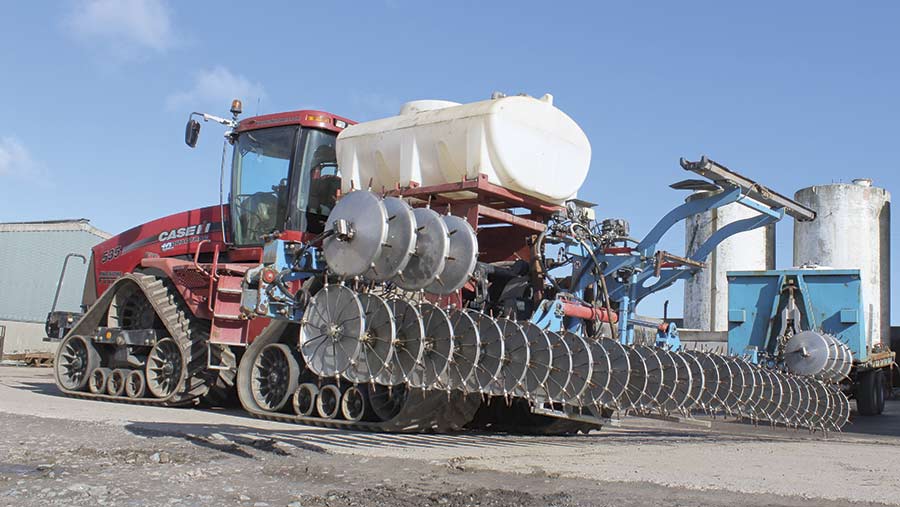
© James Andrews
See also: Eight of the best slug pelleters on test
With the help of a couple of other farmers who had adopted the technique, he set about setting up his own system for brewing the fertiliser and applying it.
We paid a visit to his farm in Ellon earlier this year to quiz him on the process and find out how it’s going a couple of seasons in.
How did you apply fertiliser before Cultan?
We’d played around with all sorts of systems over years including granular fertiliser and a few different methods of liquid fert application.
These included a Chafer demount on a Fastrac, a big Berthoud trailed sprayer and a couple of self-propelled machines. Latterly, we were using a Bateman RB35 with 4,000-litre tank and 36m booms.
Generally, winter wheat and barley received between 180kg/ha and 200kg/ha of nitrogen in three hits. Spring barley, meanwhile, would get one 120kg/ha dose.
Why did you decide to change?
We had a nightmare year in 2012 that really made me stop and think things through. Poor conditions in autumn 2011 meant we had to spend a fortune establishing crops and we had to pull in contractors to help with the workload.
On top of that, disease pressure was through the roof, input costs were high, and we were landed with the biggest chemical and fertiliser bill we’d ever had. Come harvest, bushel weights were down, yields were nothing special and prices were poor. There were plenty of sleepless nights trying to balance the books.
After that I decided we needed to come up with a plan to minimise our exposure to input price volatility. It would have been difficult to cut our agchem costs back and we couldn’t do anything about the weather, but I’d read about Cultan on the Farming Forum and thought it had potential.
Several conversations followed with German consultant York Bayer, Andrew Manfield from Manterra and John Codd, who farms in Bedfordshire and uses a similar setup to me.
However, the fact that it’s such a big undertaking meant it was some time before I decided to bite the bullet.
How did you get started?
We began by investing in a Dutch-built Duport spoke wheel injector that we bought through Andrew Manfield at Manterra back in 2013.
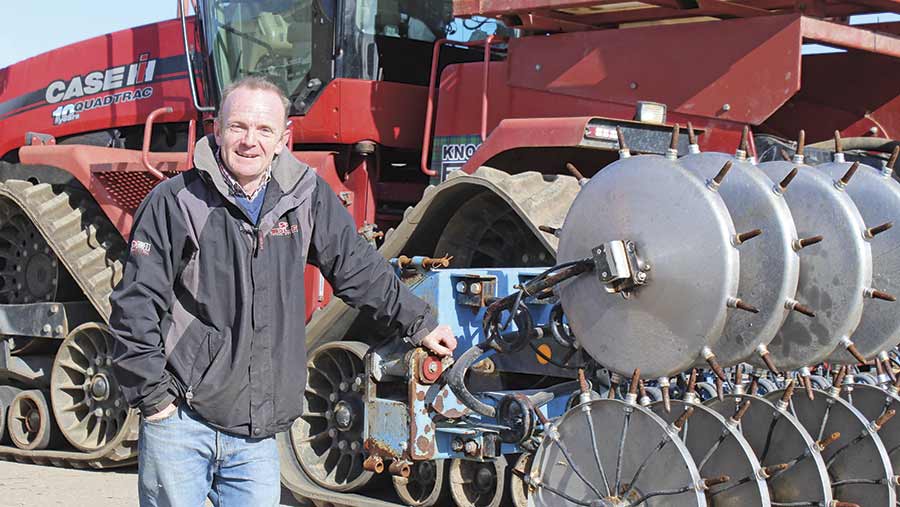
Stuart Davidson showing the spoke wheel injectors © James Andrews
This has a row of stainless-steel wheels, spaced 25cm apart, that are fitted with a series of injecting nozzles set at 6in spacings. As each spike enters the ground a valve opens and injects a blob of the fertiliser liquor. Unlike broadcasting fertiliser on the surface, this places the nutrient in the plant’s rooting zone, just where it’s needed.
Originally the Duport injector was 8m wide, but the factory extended it to 10m to fit in with our 30m CTF system. Then we had to fit tanks and plumbing, with which we had a lot of assistance from AM Philip at Forfar, as well as deciding what we were going to mount it on.
What are you pulling the injector with?
Despite it being a heavy machine, we decided to fit the Duport kit on our Case Quadtrac.
This is because it could carry the whole setup without needing to drag a trailed tank, meaning we could actually travel on our wet ground earlier.
The tracks make very little mess anyway and because we run in the same CTF wheelings as our combine and chaser bin, any damage is confined to a small area. Also, because the job needs very little power, the tractor is only burning about 3 litres of diesel per hectare.
The spoke wheel injector itself hooked straight on the three-point linkage and we fabricated a steel sub-frame so that we could mount a 3,000-litre liquid fertiliser tank on the rear deck.
This is secured using just four bolts and we have a similar frame that holds a 2t seed hopper so that we can go drilling with our modified Watkins Quadtill with Horsch Pronto disc coulters.
We also have a 2,000-litre front tank that bolts on in place of the underbelly weights. Case-IH was very helpful making sure we didn’t exceed the track units’ load limit, but at 30t all in we were pretty close.
The whole system is controlled by an Ag Leader Integra display that was set up for us by Precise Solutions. There’s also a flow-based rate control system, which means as we speed up or slow down the pump speed will change accordingly.
We’ve got RTK guidance, too, which gives us GPS auto-shutoff with switchable manual or automatic three-section control.
How do you brew the liquor?
The basic principle is that you dissolve ammonium sulphate crystals in water until you get a saturated solution – a bit like a really sugary cup of tea.
To do this on an industrial scale we took an old milk tank, cut the top out and fitted a very fine mesh suspended floor. We tip the crystals into this with the telehandler and pass water through the tank until it won’t absorb any more.
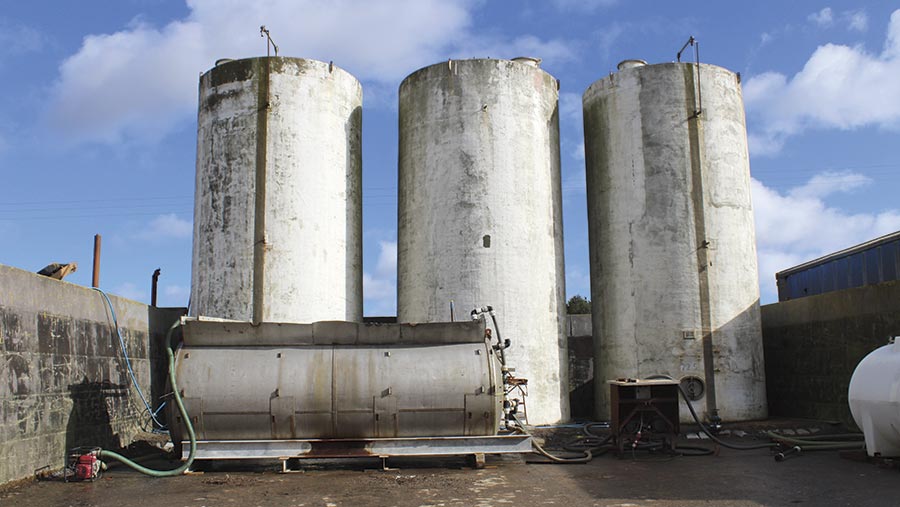
Nitrogen liquor brewing plant © James Andrews
The water itself is stored in three 100,000-litre tanks, which we fill to about 70% capacity. We then mix each tank in turn, letting gravity force it into the top of the old milk-tanker mixing vessel.
Then, after it’s trickled through the ammonium sulphate crystals a 3in Honda pump pushes it back into the top of the storage tank. We keep cycling the liquid round until it reaches its maximum strength.
Once it’s in solution the crystals don’t tend to settle out, unless temperatures are well below freezing for a prolonged period of time.
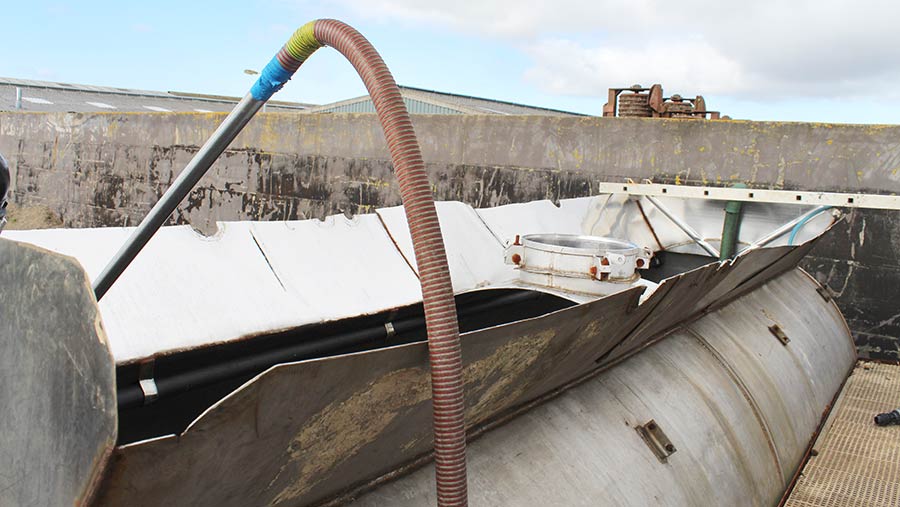
Ammonia and urea hopper © James Andrews
The main downside with ammonium sulphate it that it only creates a liquor that’s 8.1% N, so you need to apply large amounts of liquid to give the plant everything it needs for the season.
However, we’ve just started adding urea at the end of the process to help increase the nitrogen concentration in the liquor and reduce the application rate. This year we got it to 15% N, which was confirmed with a lab test.
How do you transport the liquid to the injector?
We’ve got two home-made bowsers that are plumbed so that we can fill the Quadtrac’s front and rear tanks simultaneously.
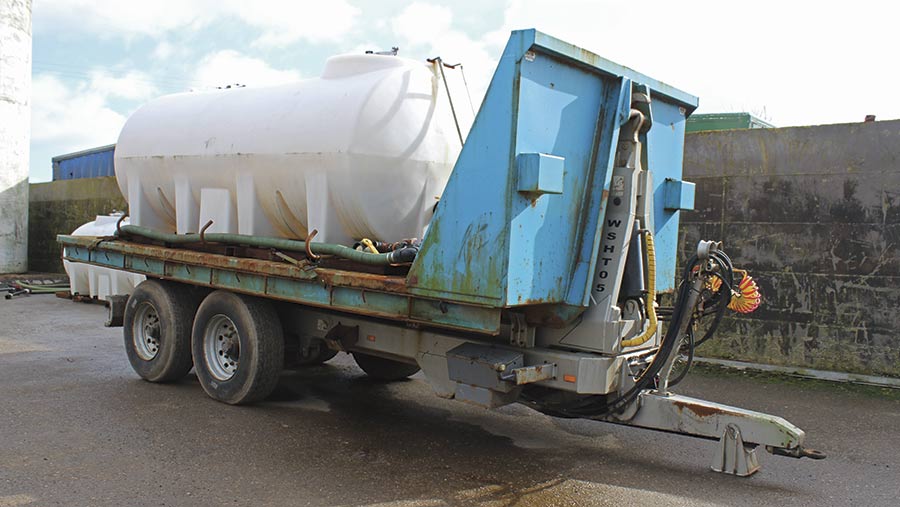
Bowser © James Andrews
The rear tank is filled by a 3in Honda pump, but the front has its own pump that draws off a different outlet on the bowser. Both fill in about seven minutes, so we’re not waiting around for too long.
In our first season, we did 290 fills, so there was a considerable amount of downtime. But that should be a lot less now that we’re using urea as well.
How much are you applying?
We didn’t want to over do it in the first season so we started by applying 130kg/ha of N to our winter barley as soon as we could travel in the spring.
Due to the low concentration of nitrogen in the liquor, that worked out at a fairly scary application rate of 1,600 litres/ha.
With 5,000-litres on the machine that meant we were covering just over 3ha to a fill, travelling at speeds of up to 10kph. Clearly this was pretty slow progress compared with a standard sprayer, but at least we only had to go through the crop once.
Later in the season we did a canopy assessment with a Yara N-sensor and worked that the crop was about 20kg/ha short. We put some granular fert on to boost the levels and it went on to yield just over 9t/ha, which was about the average for us that season.
The following year we upped the rate to 150kg/ha and when we tested the canopy it was bang on and we didn’t have to do any topping up.
Do crops look different?
The most notable differences are that crops look a much deeper shade of green and they’re considerably shorter.
The science behind this is that the plant produces larger root structures when it takes in nitrogen in the ammonium form. This makes them more efficient at absorbing nutrients, giving them a more lush appearance (see What is Cultan?).
Farm facts: Knockothie Farms
- Size: 2,000 acres with 1,800 acres of cropping
- Cropping: Winter wheat, winter barley, winter oilseed rape and spring barley
- Frontline machinery:
- Tractors: Case-IH Quadtrac 535, Magnum 7250 and John Deere 7530
- Combine: Case Axial Flow 9010
- Chaser bin: Horsch 16t
- Cultivation kit: Custom-built Philip Watkins Quadtill with Horsch Pronto coulter bar, 6m Kverneland CTD, 10-furrow Kverneland plough, five-furrow Kverneland plough
- Fertiliser spreaders: Duport 10m spoke wheel injector, Amazone Profi S granular spreader
Also, because the growth is concentrated in the roots there’s less top growth. In fact, the crops are so much shorter that we’ve stopped using growth regulator altogether. That’s saved us 30% on chemical costs from the outset.
Yields have remained fairly static so far, but it’s a little early to tell if there will be any long-term benefits.
How much did the system cost?
The main outlay was for the Duport injector bar, which including extending it from 8m to 10m cost £25,000.
The rest of the parts, including the tanks for the Quadtrac, set us back about £10,000.
As for the brewing plant, we had most of the kit on the farm already, but we did have to fork out for the three 100,000-litre tanks, plus the haulage and hire of a crane for the day to get them into place.
Is it worth the effort?
Definitely. A lot of people thought we were mad, particularly when we put the kit on a Quadtrac and they saw the massive volumes of liquid we were applying.
But now that we’ve had a couple of years to iron out the problems, it’s not that arduous and we’re already starting to see the benefits.
If we’d been using conventional nitrogen in 2015 our bill would have added up to £120,000. But with the Cultan system we paid about £92,300, with no yield penalty.
However, it’s not just about the headline cost saving. Hopefully the system will be more sustainable, better for soil health and we’ll see less fluctuation in our input costs.
What is Cultan?
Cultan stands for controlled uptake, long-term ammonium nutrition, which means you only need to apply one dose a year, unlike ammonium nitrate.
The product itself is an ammonium sulphate solution, sometimes containing urea, which is injected in the rooting zone. This positively charged liquid binds to soil particles, meaning it doesn’t leach or suffer from volatilisation, even when large quantities are injected.
So how does it work? The theory is that a plant’s root system naturally prefers to use ammonium as a nitrogen source. This is because it converts ammonium to nitrogen in its root structure, which is supposedly 25% more efficient. In turn, this gives the plant stronger root growth without affecting straw length.
By injecting a stable source of ammonium nitrogen in the rooting zone, the Cultan system gives the plant exactly what it wants. Also, because the fertiliser is placed into the moist root zone, it doesn’t have to rely on rainfall to wash it in. The fact it binds to soil particles means it remains available to the plant throughout the growing season, too.
Meanwhile, traditional nitrogen application methods combined with intensive tillage ensure that any ammonium nitrogen is rapidly converted to nitrate, which is less efficient for the plant to use.
This also tends to produce more top growth, which is why growth regulator is required.

